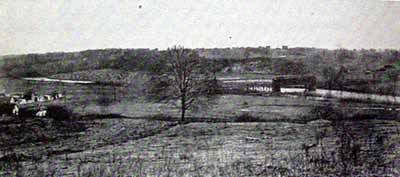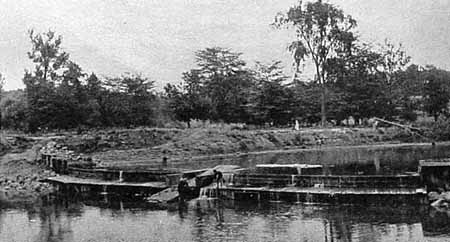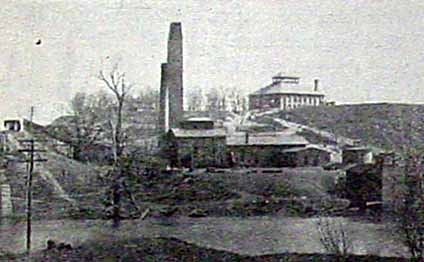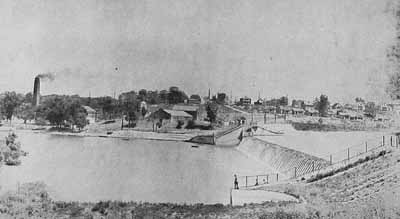|
THERE'S
a great difference between the old well in
Howell's Hollow and beautiful Lake Decatur, yet
both served the same need of Decatur - the need
of a water supply - and the transition from one
to the other is just another story of the
development of the city.
For many years Decatur
depended upon wells, public and private, for its
water. The city had a public well on the
"old square."1
In the new square were two cisterns. Close
to town were a number of good springs.
In the early years Decatur
suffered a number of disastrous fires which
would have been avoided if the city had had an
adequate water supply, and fire fighting
apparatus for using it. Chief of these was
the Revere hotel fire, the story of which is
told in another chapter.
WATERWORKS
First mention in city council
records of a waterworks system is made in the
report of the council meeting on Jan. 11, 1869,
when an ordinance was passed to establish such a
system. It provided for borrowing $50,000.
However, Decatur did not get any waterworks
then. Mayor Isaac C. Pugh thought
it was a bad move. He complained that some
of the rich citizens were not paying their
taxes, and he did not want to burden the city
with debt. The ordinance was vetoed and
the matter dropped.
After Franklin Priest
had been elected mayor in the spring of 1870 the
matter of a waterworks system came up again, due
to the fact that Decatur had been selected as
the location of a rolling mill, and ample water
supply for the mill had been promised.
At a meeting Dec. 1, 1870,
the council voted to lay pipe from the well on
East Wood street to the Illinois Central tank at
the depot, thence east to the rolling mill.
The well was located in what was known as
Howell's Hollow, in the neighborhood of East
Wood street and Broadway, on land belonging to
Gilbert Howell. This well had been
dug during the summer of 1870. It was 10
feet square and 30 to 40 feet deep. On
Feb. 6, 1871, the council again to action to lay
pipe to the rolling mill.
At that same meeting, the
council, realizing that the well would not
furnish an adequate supply of water to the mill,
decided to build a waterworks plant at the
river, and bonds to the amount of $30,000 were
issued. Work was stopped then on some
additional wells which had been started.
Considerable sentiment in
favor of a waterworks plant had been worked up
by this time, due mostly to the meeting of
citizens held Jan. 16, which had been addressed
by Honorable T. T. Flagler, president of
the Holly Manufacturing company of Lockport, N.
Y.2
Promoters and opposers of the project had
gathered at that meeting in such numbers that
the council rooms would not hold them all and it
was necessary to adjourn to the court room.
Mr. Flagler was a persuasive talker, and
the citizens were so filled with enthusiasm over
the prospect of the water system that they
passed a resolution to the effect that the city
council be asked to contract for machinery for
the waterworks plant, and that the work be
completed at a cost not to exceed $100,000.
The resolution was presented by E. O. Smith.
The city had already
purchased a Cameron pump, which had been
installed at the well on Wood street, on Dec. 1,
1870. This pump had a capacity of 500,000
gallons of water daily, but it was soon found
that it was not sufficient. That pump had
cost the city $1,460.
Ground for the pumping
station on the river was purchased May 29, 1871,
from Peddecord & Burrows. It was known as
the Priest distillery property. It was
voted to lay a twelve inch main from the station
to Lincoln square, a distance of one mile.
Dodson & Holmes were given a contract to furnish
a No. 1 Holly pump, two No. 6 Holly patent
rotary fire pumps, and 5,280 feet of twelve inch
main. All of this was to be installed for
$34,937. This equipment was guaranteed to
furnished 1,000,000 gallons of water a
day.

THE SANGAMON VALLEY ABOVE
WATERWORKS (ABOUT 1900)
Nearly all this land now is
covered by the lake. The old covered
bridge was replaced by the county bridge.
The houses in the picture were all removed when
the lake was formed.
When the plant was completed
Benson N. Henkle was installed as chief
engineer. H. Mueller was made city
plumber at the same time.
When the first test of the
plant was made, the entire town turned out to
see it. The test took place at the corner
of Broadway and East Main, where a temporary
fireplug had been installed. The test
consisted of throwing water over the old oil
mill.
The next necessity was a
reservoir, as it had been found that whenever
the river was high, the water was too muddy for
use. In 1874 a reservoir 100 feet long,
ten feet wide and six feet deep was furnished an
excellent supply of filtered water, the water
seeping through gravel from the river. For
emergencies, a direct connection was made from
the reservoir to the river.
The building of a dam across
the river, to provide a larger supply of water
when the river was low, was the next step taken.
This was done in October, 1878.
Decatur was continually
growing and was constantly using more water,
making additions to the plat necessary. On
March 9, 1882, a Clapp & Jones pump was
purchased, and installed to take the place of
the Holly pump. It had pumping capacity of
3,000,000 gallons of water a day. Its cost
was $7,550.

THE FIRST DAM
On Jan. 14, 1884, two pumps
were bought from E. P. Allis and Company
of Milwaukee, costing $14,500. These two
had capacity of 2,000,000 gallons each.
They are still in use. These pumps raised
the daily capacity to 7,000,000 gallons.

WATERWORKS PLANT IN 1896
It was not long until the
need of a more adequate filter plant was felt,
and in the year 1894 contract was made for a
Warren filter made by the Cumberland
Manufacturing company of Boston. This and
other additions cost $50,000.
In 1908-1909 a new pumping
station was erected at a cost of $225,000 and a
6,000,000 gallon pump put into operation.
In 1910 a new light plant was
erected at a cost of $110,000, the city having
installed a light plant about 25 years before.
A new dam also was built that year.
The city voted March 28,
1913, for a $135,000 bond issue to erect a new
filter plant, and the contract was given later
to the New York Continental Jewel Filtration
company. The contract price was $129,899.
CREATE LAKE

ONE VIEW OF LAKE
The next few years saw the
biggest development in the story of the water
supply for Decatur - the water impounding
project which included the building of a dam and
creation of a lake. This lake, called Lake
Decatur, fourteen miles long and from one-half
to a mile wide, contains enough water to keep
Decatur supplied for two years without a drop of
rain. Eight billion gallons of water are
impounded. Decatur need never fear a
shortage of water. The total cost of the
improvements was more than $2,000,000.
The dam was erected at a cost
of $725,000. The length of the spillway is
480 feet, and the total length of the dam is
1900 feet. It is built to hold water at a
610 foot level above sea, and the addition of
flash boards will raise the level to 612 feet.
The water level before the creation of the lake
was 595 feet.
It was necessary to purchase
4,000 acres of land at a 615 foot level for the
lake. The land cost $599,000. Other
expenses in connection with the project were
$109,558 for clearing the land, $450,000 for
roads and bridges, and $128,000 for riprapping.
At the time of this development of county bridge
was raised 14 feet, giving it a height of 16
feet above the lake level.
The dam itself was financed
by the city, but the rest of the project was
taken care of by the Decatur Water Supply
company, a corporation of Decatur citizens
formed to provide $1,000,000. Stock in the
company in five days was oversubscribed to
$1,200,000.

COUNTY BRIDGES
Upper - Before being raised
Lower - After being raised.

WATERWORKS DAM IN 1929
According to the agreement
made, the income from city water rents is used
to pay for the operation of the waterworks
plant, to pay dividends on preferred stock of
the company, and to retire stock. Within
sixteen years from the date of organization all
the stock will have been retired, and the land
deeded to the city.
This project, under way for
three years, was completed in 1923. A
five-day celebration marked its completion.
Improvements and additions
have continued at the waterworks plant. In
1926 additions costing $143,689.02 were made to
the filter house. This increased the
capacity of the plant to 18,000,000 gallons of
water daily. Other recent improvements are
a water softener, chlorinator, and new
carbonator plant.
Water mains cover the entire
city, and the number of water meters in use in
1929 was 13,625. That year the average
daily consumption of water was 7,000,000
gallons.
The name of Harry
Ruthrauff was linked with the waterworks
history for many years. He was employed
first in June, 1888, as a helper or calker of
water pipe, then served as foreman and later as
water inspector and plumbing inspector. In
1911 he was elected one of the city
commissioners and was made head of the
department of public property, which gave him
oversight of the waterworks. He served in
that capacity until 1927.
--------------------
1.
The first public well was authorized June 6,
1831, when the county commissioners gave James
Johnson authority to dig a well in the town of
Decatur on Block 2, west half of lot 8, for a
public well. Years later a well was dug in
the middle of the old square and for many years
an old wooden pump stood there, with a tin cup
chained to it. This old well was filled up
at the time the transfer house was built.
2.
At the time of the mass meeting of citizens in
1871 there was some opposition to the building
of the waterworks plant. Franklin Priest,
mayor, who was a far-sighted man, but whose
advice was not always followed, made the remark
at that time: "This is going to be a city.
We should now begin to buy land for parks and
sites for firehouses. Some day we will
have to pay a high price for them, but now we
can get land at the price of vacant property."
The land he was talking about was included in
the section bounded on the north by the Wabash,
on the east by Hilton street, on the south by
Wood street, and on the west by Monroe Street.
Some objectors said: "We've got a park now,
Central park, but it is not used by anything but
the rabbits.
<PREVIOUS>
<NEXT>
<CLICK HERE TO RETURN TO TABLE OF CONTENTS>
|